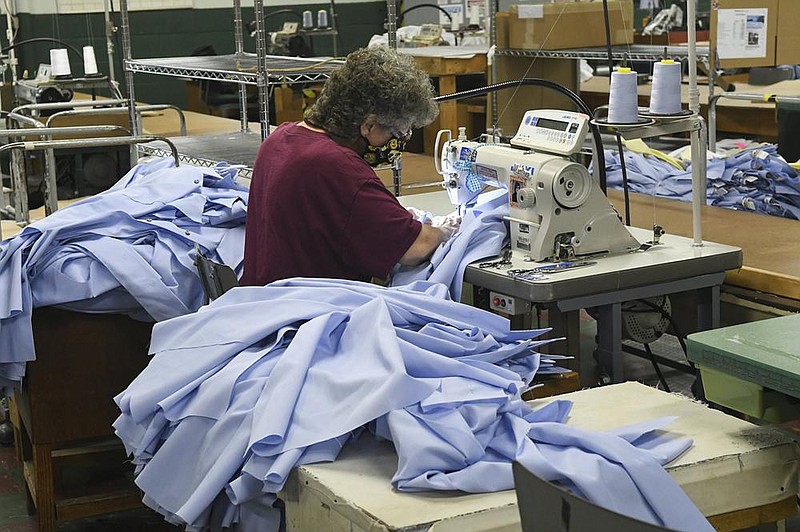WASHINGTON -- U.S. manufacturing expanded in October at the fastest pace in more than two years, fueled by the strongest orders growth since early 2004 and a pickup in employment.
The Institute for Supply Management, an association of purchasing managers, said Monday that its manufacturing index rose by 3.9 percentage points to a reading of 59.3% last month, up from 55.4% in September.
It was the highest level for this closely watched barometer of manufacturing health since September 2018. Any reading above 50 signals that manufacturing is expanding.
The gauge had fallen into recession territory from March through May as much of the country shut down in an effort to contain the coronavirus.
Of the 18 industries covered in the report, 15 reported expansion in October, with strong growth in fabricated metals, clothing, food and beverages, chemicals and computers and electronics.
Timothy Fiore, chairman of the institute's manufacturing survey committee, said manufacturing was being helped by strong demand in such areas as home construction and auto sales as the country came out of spring lockdowns.
[CORONAVIRUS: Click here for our complete coverage » arkansasonline.com/coronavirus]
Stronger sales and capital investment helped deplete inventories, resulting in increased factory orders.
A measure of customer inventories retreated 1.2 points to 36.7, a fresh decade low. The drop was the sixth straight since the height of the pandemic. The measure of factory stockpiles rose to 51.9 from 47.1.
"Customer inventories being too low is always good for future production," Fiore said. "This is a strong indicator that factories have an opportunity for the month of November and December."
But economists are concerned about the country heading into a repeat of the spring lockdowns because of surging covid-19 infections. Many parts of Europe are already reimposing restrictions.
"Manufacturing rebounded strongly with fewer restrictions on economic activity and stimulus efforts, but the path forward will be more difficult as the economy continues to cope wit the pandemic," said Gus Faucher, chief economist at PNC Financial. "An inability of Congress to pass further fiscal stimulus is a significant downside risk."
The strength in October reflected gains in key areas such as employment and inventories, which both moved from contraction to expansion in October. The new orders component of the index was also strong, rising to the highest level since 2004.
Rubeela Farooqi, chief U.S. economist at High Frequency Economics, said that while October was a strong month for manufacturing "the outlook is less positive given renewed virus outbreaks that will disrupt activity and weigh on demand."
Another welcome development was an increase in the exports index, which rose to the highest level in more than two years and indicated a firming in overseas demand.
Separately, U.S. construction spending rose 0.3% in September, the fourth straight monthly gain after a coronavirus-caused spring swoon, although it was a smaller gain than analysts had expected.
The Commerce Department reported Monday that the September gain follows a downward revised gain of 0.8% in August. Spending on residential construction was strong yet again, with single-family home projects jumping 5.7%.
Demand for single-family homes remains healthy as buyers rush to the market pushed by historically low interest rates under 3%. A lack of homes for sale has builders rushing to fill the void.
Total residential construction was up 2.7%, with total private construction up 0.9%.
Spending on government construction projects fell 1.7%, with declines everywhere except health care facilities, schools and waste disposal sites. Government spending on projects related to public safety and streets and highways both shrunk by more than 5%.
Spending on public projects has been expected to fall as the state and local governments collect less tax revenue from individuals and businesses because of the economic effects of coronavirus and related closures.
Spending on nonresidential private construction fell by 1.5%, with churches and offices the only categories to see growth.
During the first nine months of 2020, construction spending is up 4.1% over the same period last year.
The figures follow a report last week that pointed to firmer consumer spending and income gains in September and suggest economic growth could be stronger than forecast this quarter, though still down from the third quarter's record pace. Firmer demand helps explain the surge in the supply management institute's gauge of orders, which was accompanied by a pickup in production and encouraged more producers to add to payrolls.
Information for this article was contributed by Martin Crutsinger and Matt Ott of The Associated Press and by Jarrell Dillard of Bloomberg News.

